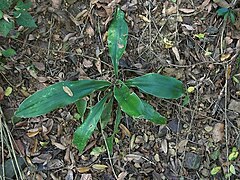|
Dracaena aletriformis
Dracaena aletriformis is commonly known as the large-leaved dragon tree. These plants are found in forest in the eastern areas of South Africa from Port Elizabeth to northern and eastern Limpopo.[2] They are also found in Eswatini,[2] but are most common in the coastal and dune forests of KwaZulu-Natal.[3] TaxonomyThis plant has 8 synonyms.[1] In the APG III classification system, the genus Dracaena is placed in the family Asparagaceae, subfamily Nolinoideae (formerly the family Ruscaceae).[4] It has also been placed in the Agavaceae (now the subfamily Agavoideae) and the Dracaenaceae. Like many lilioid monocots, it was formerly placed in the family Liliaceae (lily family).[2] DescriptionSingle stemmed or branched (usually at the base). The leaves are large and strap-shaped in rosettes at the tips of the stem/s. The leaves are leathery, shiny, and dark green, with whitish margins. These plants may grow up to 4 metres (13 ft) tall. The flowers are produced on a much branched flowering head. The flowers are silvery-white and described as sweetly or strongly scented.[3][2] The two-lobed berry-like fruit ripen to a reddish-orange colour. Ecological significanceThe flowers open from late afternoon to early morning and attract night-active pollinator moths. Birds eat the fruit; helping to remove the orange pulp which contains a growth inhibitor that otherwise slows germination of the seeds.[2] Snails and the larvae of the Bush Night Fighter butterfly, Artitropa erinnys, feed on the leaves.[2][5] Birds and mice nest among the leaves of these plants.[3] Gallery
ReferencesCitations
SourcesWikimedia Commons has media related to Dracaena aletriformis.
|
||||||||||||||||||||||||||||||||




